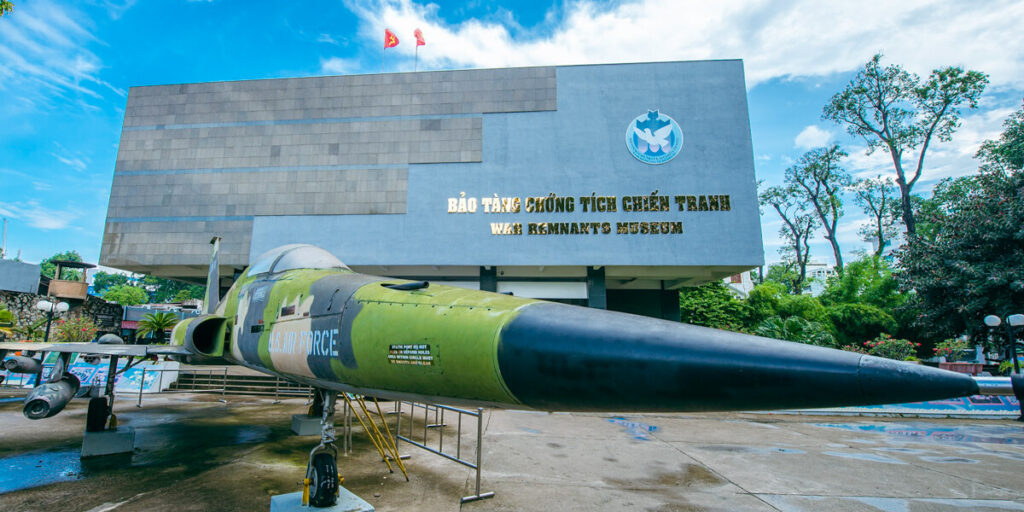Vietnam, a country with a tumultuous history, offers a unique blend of war remnants and cultural heritage that captivates visitors from around the world. From the bustling streets of Ho Chi Minh City to the ancient towns of Hue and Hoi An, Vietnam’s rich past and cultural diversity are waiting to be discovered. In this blog, we will delve into the war remnants and cultural heritage of Vietnam, exploring the must-visit destinations that shed light on the country’s history and traditions.
Ho Chi Minh City (Saigon): War Remnants Museum
The War Remnants Museum in Ho Chi Minh City is a must-visit destination for anyone interested in gaining insights into the Vietnam War and its profound impact on the country and its people. The museum showcases a collection of photographs, documents, and artifacts that tell the stories of the war from the perspective of the Vietnamese people.
As you enter the museum, you are immediately confronted with powerful images that depict the horrors of war. The photographs capture the devastation, suffering, and human tragedy that occurred during the conflict. These images, accompanied by detailed explanations, provide a raw and unflinching account of the war’s impact on civilians, soldiers, and the environment.
The museum is divided into several themed exhibitions, each focusing on different aspects of the war. One section highlights the use of chemical weapons, particularly the infamous Agent Orange, and its long-lasting effects on the Vietnamese population, including birth defects and health issues that continue to this day.
Another exhibition sheds light on the role of international journalists who covered the war, often risking their lives to report the truth. Their photographs and personal accounts provide valuable insights into the war’s realities and the challenges faced by journalists in documenting the conflict.
The War Remnants Museum also features a collection of military equipment, including tanks, aircraft, and artillery, giving visitors a sense of the scale and machinery involved in the war. These displays serve as a reminder of the devastating firepower unleashed during the conflict and the impact it had on the Vietnamese people.
While the museum presents a perspective that reflects the Vietnamese viewpoint, it also promotes a message of peace and reconciliation. It emphasizes the need to learn from the past to prevent such conflicts from recurring and advocates for a world free from the devastation of war.
Visiting the War Remnants Museum can be an emotional and thought-provoking experience. It provides an opportunity for reflection, fostering empathy and understanding for the Vietnamese people and the challenges they faced during a tumultuous period in their history. It is a solemn reminder of the cost of war and the resilience and strength of the human spirit.
As you leave the museum, take a moment to absorb the significance of the exhibits and the stories they tell. The War Remnants Museum stands as a testament to the importance of remembering history, honoring those who suffered, and striving for peace and reconciliation.
Vietnam’s cultural heritage and war remnants intertwine to create a profound and complex narrative. Exploring these aspects of Vietnam’s past allows visitors to gain a deeper understanding of the country, its people, and their journey towards healing and progress. It is a journey that evokes a range of emotions, from sadness and reflection to hope and admiration, as one witnesses the indomitable spirit of the Vietnamese people in the face of adversity.
Cu Chi Tunnels: An Underground Network
Just outside of Ho Chi Minh City, you’ll find the Cu Chi Tunnels, an extensive network of underground tunnels that served as a base for the Viet Cong during the Vietnam War. Embark on a guided tour to explore the tunnels and learn about the ingenious tactics employed by the Vietnamese soldiers. Crawling through the narrow passageways and experiencing the conditions endured by the soldiers provides a glimpse into the challenges they faced. This visit offers a unique opportunity to witness firsthand the resourcefulness and determination of the Vietnamese people during the war.
Hue: A Window into the Imperial Past
Traveling north to the city of Hue, you’ll discover a rich cultural heritage and remnants of Vietnam’s imperial past. Hue was the capital of the Nguyen Dynasty, the last royal dynasty in Vietnam. Explore the Imperial City, a UNESCO World Heritage site, and witness the grandeur of the Nguyen emperors’ palaces, temples, and tombs. Take a boat ride along the Perfume River, passing by Thien Mu Pagoda, a historic Buddhist temple that offers stunning views of the surrounding landscapes. Immerse yourself in the city’s history and gain insights into Vietnam’s feudal era.
Hoi An: Ancient Town and Cultural Heritage
Continue your journey to Hoi An, a charming ancient town that has beautifully preserved its cultural heritage. Hoi An’s narrow streets are lined with well-preserved traditional houses, Chinese temples, and Japanese merchant houses, reflecting its prosperous past as a trading port. Explore the atmospheric lantern-lit streets, visit the iconic Japanese Covered Bridge, and immerse yourself in the town’s vibrant ambiance. Hoi An is also renowned for its traditional crafts, including tailor-made clothing, lantern making, and silk production. Participate in workshops to learn these traditional skills and bring home unique handmade souvenirs.
My Son Sanctuary: Champa Civilization
A short distance from Hoi An, the My Son Sanctuary is a UNESCO World Heritage site that offers a glimpse into the ancient Champa civilization. Explore the temple complex, which was once a significant religious and cultural center of the Cham people. Marvel at the intricate carvings and architecture that reflect the Hindu influences on the Champa civilization. Witness traditional dance performances at the site, where dancers bring the ancient Cham culture to life through graceful movements and colorful costumes.
Dien Bien Phu: Battle Remnants and Historical Significance
Venturing to the northwest of Vietnam, you’ll reach Dien Bien Phu, a region of great historical significance. It was here that the decisive Battle of Dien Bien Phu took place in 1954, leading to the end of French colonial rule in Vietnam. Visit the Dien Bien Phu Museum to learn about the battle and its impact on Vietnam’s struggle for independence. Explore the memorials and monuments dedicated to the fallen soldiers, paying homage to their sacrifice and the pivotal moment in Vietnam’s history.
Vietnam Tour Packages
To make the most of your journey through Vietnam’s war remnants and cultural heritage, consider opting for a tour package from India. Vietnam Tour packages From India often provide a well-organized itinerary, including transportation, accommodation, guided tours, and expert knowledge about the destinations. Look for reputable tour operators in Delhi who specialize in Vietnam tours to ensure a seamless and immersive experience.
Visiting Vietnam’s war remnants and cultural heritage from India is an opportunity to gain a deeper understanding of the country’s history, resilience, and cultural diversity. From the somber reminders of the Vietnam War to the ancient imperial cities and vibrant cultural traditions, Vietnam offers a journey that enlightens, educates, and inspires. So embark on this exploration, discover the war remnants, and immerse yourself in the cultural heritage that makes Vietnam a truly remarkable destination.


